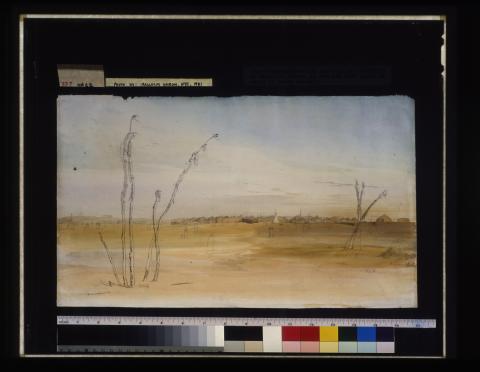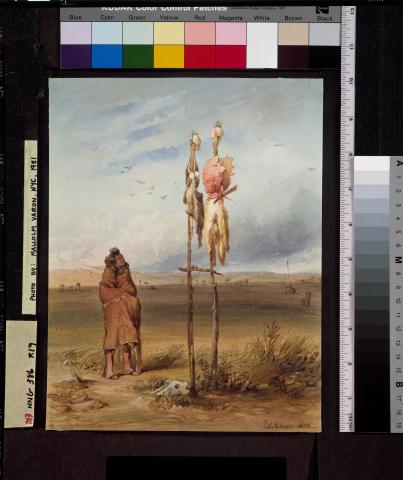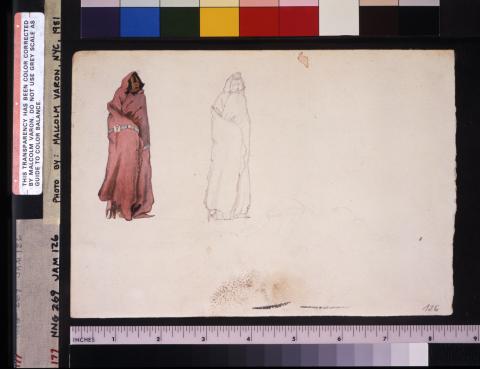November 19, 1833
19 November: The night had been starlit, calm, and clear. The morning was calm ⟨[with]⟩ moderate frost, hoarfrost, ⟨[and]⟩ bright sky. Wind northwest hora 9. I did not feel well and took castor oil. After breakfast Bijou left us. In his place came Síh-Chidä, who had brought me a few of his drawings again yesterday. The hunters rode out today because we no longer had any meat. One of their horses ran away from them and ⟨[then]⟩ came back. About noon the weather was pleasant, because there was no strong wind. Mr. Bodmer drew a view of Mih-Tutta-Hangkusch with a few sacrificial medicines.
Dreidoppel went out and saw a wolf, which came right away because of the lure. He missed it with his gun ⟨[loaded with]⟩ ball. Several Indians came into the fort—among them, Medicine Bird and three young people. At twelve o’clock, 44°F ⟨[6.7°C]⟩. Wind as in the morning. The finches (Fringilla linaria) were again in the plants at the creek. In the afternoon the wind was stronger again and more unpleasant. Mr. Bodmer went out again to draw.
A young Indian, Síh-Sä (Red Feather), spoke about the great medicine rock of which Lewis and Clark tell (vol. ⟨[——]⟩ p. ⟨[——]⟩). It is located on the bank of the Cannonball River, and one may get there on foot from the Mandan villages in a fast two-day march; if one walks slowly, in three days. The rock, large as a house [and] rounded off on the top, is supposed to have consisted formerly of a soft mass, because on it one can see today many impressions of the feet of animals and human beings, of grown-ups and children, deer, elk, etc. The human feet are all bare; one may also see the tracks of travois that have been pulled across it. The rock is said to be sandstone. The Mandans, who call it the medicine boulder, Mih-Chóppenisch (‘ch’ velar, ‘e’ articulated only half ⟨[ə]⟩), and the Hidatsas, who know it by the name of Wíh-Ihna-Katachísch (‘Wih-Ihna’ very short, ‘ch’ velar) Wíhdä- [Page 3:33] Katachí(‘ch’ velar), go there when their war parties move out. They do not go to the rock during the first evening but camp before and sacrifice a few items, like small pieces of cloth and such, to the rock. The next morning they walk up to it and ⟨[someone]⟩, especially the partisan, interprets the impressions and figures on the rock and predicts the outcome of their ⟨[proposed]⟩ venture. Then they smoke. ⟨[For more]⟩ about this subject see the history of the Mandans in the next chapter.
We wanted to make frequent use of the long evenings to write down the Mandan, Hidatsa, Arikara, and Crow languages as correctly as possible according to Indian pronunciation. For all these languages, it is easy to find Indians here who speak them fluently. All the Mandans speak Hidatsa; Mató-Tópe and others, fluent Arikara; but the Hidatsas only seldom speak the Mandan language.
Dreidoppel went out and saw two wolves on the prairie, but he could not get to them. White wolves are seldom seen in ⟨[the]⟩ vicinity of the fort. In the hills he saw something white, which he thought was a buffalo head ⟨[because]⟩ there were so many lying around. However, when he came closer, a white rabbitM17Lepus variabilis. walked away, which he shot. It was a heavy rabbit, completely white with only a bit of gray and yellow on its ears and the top of its head.
Mr. Bodmer was ⟨[out]⟩ drawing and saw an Indian doing penance all day long today. He leaned on the medicine signs, walked up and down near them all day, and ate nothing; ⟨[he]⟩ stayed overnight and often for several days. This is done to achieve some purpose, perhaps to prepare ⟨[one]⟩self for a military expedition next spring. Evening calm and pleasant, not very cold.
In the adjoining room, the Indians were singing their monotonous songs, which have remained the same for centuries. ⟨[As accompaniment]⟩, they used the parchment window of the room as a drum. This entertainment lasted several hours without interruption. In the evening we wrote down more than a hundred words of the Mandan language. Night pleasant, calm, and not cold.





